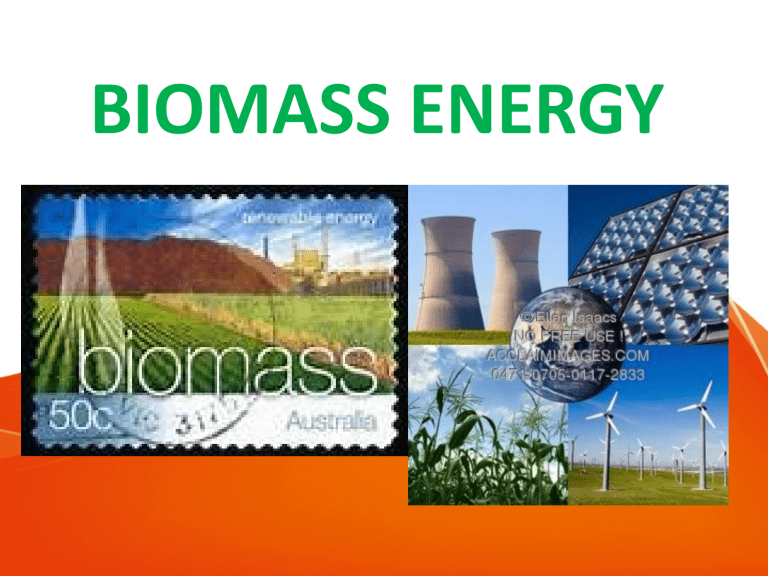
BIOMASS ENERGY Types of Resources Renewable resources • The definition of renewable energy includes any type of energy generated from natural resources that is infinite or constantly renewed. Examples: solar, wind, and hydropower. Biomass •Plant and animal material, especially agricultural waste products, used as a source of fuel. Biomass •Plant and animal material, especially agricultural waste products, used as a source of fuel. SOURCES OF BIOMASS We used to produce energy from biomass are three main categories: energy conversion technologieso Combustion o Gasification o Pyrolysis Primary energy conversion technologies Combustion - direct combustion of biomass is the most common way of converting biomass to energy - both heat and electricity. Compared to the gasification and pyrolysis it is the simplest and most developed. Gasification - gasification is a high-temperature (1200-1400 Degree Celsius)thermo chemical conversion process but the process is used for production of gas, instead of heat. Pyrolysis - thermal decomposition occurring in the absence of oxygen. We use pyrolysis to produce a liquid fuel, bio-oil or pyrolysis oil. 1. Biogas • Getting energy out of biomass by burning it, turning it into a liquid or by turning it into a gas called bio gas. • It contains about 65% of methane gas as a major constituents 2. Biofuel . Biofuel (also called agro fuel) is a bioorganic fuel .It is obtained by the fermentation of biomass. • The process by which micro-organisms break down complex organic substances generally in the absence of oxygen to produce alcohol and carbon dioxide is calledFermentation. Examples of Biofuel Ethanol: It is produced from sugarcane .Its CALORIFIC VALUE is less than petrol. It also less heat when compare to petrol. Methanol: It is easily obtained from ethanol .Its CALORIFIC VALUE is too low when compared to gasoline and diesel. Gasohol: It is a mixture of ethanol + gasoline .It is used in cars and buses. Significance of Bio-energy Cost is low when compare to fossil fuels Biomass consumes more CO2 than is released during combustion of biomass. Differences Biofuel Bio-fuel is produced directly from plant matter typically corn, sugar cane, sugar beets, or cellulose transforming it into alcohol. Fossil fuel Fossil fuels are produced by either the decomposition of plant or animal matter over long periods of time under certain conditions such as high temperature and pressure. Fossil fuels are coal, oil, and natural gas. PLANT OPERATION • Biomass is organic compounds produced in natural processes. • These compounds are transported to the biomass plant and burned to heat water. • Steam is produced at high pressure and it moves a turbine and this moves the generator to produce electricity. ADVANTAGES • • • • • • It’s a renewable source of energy. It’s a comparatively lesser pollution generating energy. Biomass energy helps in cleanliness in villages and cities. There is tremendous potential to generate biogas energy. Biomass energy is relatively cheaper and reliable. It can be generated from every day human and animal wastes, vegetable and agriculture left-over etc. • Growing biomass crops use up carbon dioxide and produces oxygen. DISADVANTAGES • • • • • • Cost of construction of biogas plant is high, so only rich people can use it. Some people don’t like to cook food on biogas produced from sewage waste. Biogas plant requires space and produces dirty smell. It is difficult to store biogas in cylinders. Transportation of biogas through pipe over long distances is difficult. Crops which are used to produce biomass energy are seasonal and are not available over whole year. A Short Video CONCLUSIONS • Biomass plants seem a good choice because they help clean up the waste that we produce and are relatively cheap and safe, but their construction is very expensive, so only rich people can use them. They are also power generators that pollute comparatively less, but require much space and produce odor.


